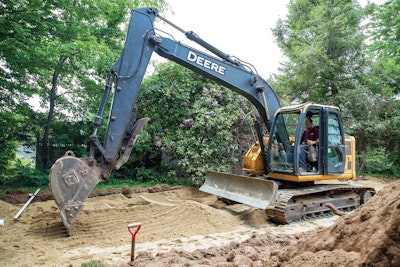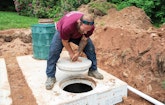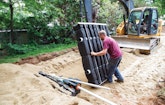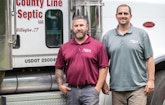
Technicians Josh Gondek, left, and Paul Meikle assemble a TUF-TITE distribution box for an onsite system in Vernon, Connecticut. (Photos by Scott Eisen)
Interested in Business?
Get Business articles, news and videos right in your inbox! Sign up now.
Business + Get AlertsJust as a four-legged stool is much steadier than one with two legs, a business that offers multiple services typically offers more stability than a single-service company.
A good case in point is County Line Septic, a full-service company that installs and repairs septic systems, performs septic system inspections and pumps tanks. It’s based in Willington, about 20 miles northeast of downtown Hartford, Connecticut.
When coupled with a strong emphasis on customer service, the combined-services approach has provided co-owners Chris Sutyla and Mike Norcross with a formula for success.
“When you can offer customers a complete package of services, they don’t have to go elsewhere for this and that,” Sutyla says. “We can take care of all aspects of septic service — we have all the bases covered.
“Also, if people go to another company for services you don’t provide, they might use that company for all their service needs and you just get pushed down the road,” he adds. “So it’s just better if you can do it all.”
Offering multiple services wasn’t part of a formal business plan. Instead, it just made sense because Norcross and Sutyla worked at the same company for several years before striking out on their own. Sutyla handled system designs and installations and Norcross managed the tank pumping, septic system repairs and inspections, Sutyla explains.
“When we came together to form a company, we decided to be a full-service company instead of picking out just one or two aspects,” he says. “We each had our niche at the other company and we decided to keep it that way.”
CONSISTENT REVENUE STREAM
The multiservice approach pays dividends in other ways, too. For example, throughout a year, some services are more in demand than others. So providing multiple services helps even out the seasonal highs and lows and keeps cash flow more consistent, Sutyla notes. Furthermore, synergies between the various branches of the company allow it to cross-market services. For example, system inspections can give the company a foot in the door for tank pumping and system repairs — and vice versa, he says.
“One thing can easily lead to another,” Sutyla says.
“Performing system inspections gets us a lot of work,” Norcross adds. “It’s much more important than pumping. Our inspections basically feed the installations and repair work.”
About 60% of the company’s revenue comes from system installations, with tank pumping and system inspections kicking in about 20% each.
Providing many services requires an array of equipment. To pump tanks, the company relies on a 2010 Peterbilt 384 equipped with a 4,000-gallon steel tank and a Jurop vacuum pump.
To install septic systems, the company owns a John Deere 135 excavator, a Kobelco SK60 excavator, a Bobcat 334 mini-excavator, a Takeuchi TL10 skid-steer and a Bobcat S160 skid-steer. The company also has invested in a 2011 Peterbilt 388 tri-axle dump truck with a Beau-Roc dumpbody, a 2019 Ford F-450 carrying a Reading Truck utility body, and a smaller dump truck that features a 2021 Ford F-450 chassis and a Mason dumpbody.
For system inspections, the company invested in a RIDGID SeeSnake pipeline inspection camera.
MAKING OUR OWN WAY
After working for about a year as a diesel mechanic following high school graduation, Sutyla realized he wasn’t cut out to work indoors. So when a septic service company offered him a job, he jumped at the opportunity. “Like a lot of guys, I like digging in the dirt and working with equipment,” he says.
The job provided him with a good foundation in the septic industry. After obtaining a commercial driver’s license, he pumped tanks and did small repairs and inspections.
Norcross started his career at a company that did utility line locating, then landed a job at a septic company that a friend owned — the same company where Sutyla worked. During a 7-year stint there, Norcross developed a range of skills, including pumping tanks, installing and repairing systems and real estate inspections.
“Then the company merged with another one, so we decided to start our own business,” Norcross says.
They named the company County Line Septic because the business was located near the Tolland and Windham County border, Norcross says.
A SLOW START
Even though Norcross and Sutyla had a broad background in the industry, it was tough going at first.
“Initially, our goal was survival — just hoping to make a living and see where the road takes us,” Sutyla says. “We found customers mostly through word of mouth because we didn’t have a lot of money for advertising. … We touched base with a lot of people.
“We put every penny we had into the business and hit the streets,” he continues. “It’s always tough when you start a business compared to buying one. We literally had nothing at the start.”
“We definitely took a risk,” Norcross notes. “We left regular paychecks behind and put everything we had into the business. All we really had was the belief in ourselves and our abilities.
Fortunately, Norcross had already developed a network of business contacts that helped the company grow from just two employees to nine in eight years. To accommodate the growth, they bought a 2,400-square-foot auto body shop in 2016 that now serves as the company’s home base.
“Even with the business contacts, getting our name out there was tough,” Norcross recalls. “We didn’t have any money for marketing — we couldn’t even get a business loan. So we rented equipment at first, then slowly bought equipment as we saved money.”
With little money available for marketing, Norcross also joined the local Chamber of Commerce as well as an organization called Business Network International.
“Those were important sources of referrals early on,” he says.
Strategic pricing for services was important to growth. Sutyla says he doesn’t want to be the highest- or lowest-priced company.
“Sometimes the low bids are so low you don’t know how they’re doing it,” he notes. “We always encourage our customers to get more than one bid. But at same time, we tell people they shouldn’t always go with the lowest bidder.”
BUILDING A NETWORK
A key strategy centered on building a network of contacts with real estate agents to obtain referrals for systems inspections, which in turn led to pumping, installation and repair work, Sutyla says.
“Mike did a lot of that networking,” he says. “He’s the face of our company.
“Developing relationships with real estate agents was our main stepping stone,” Sutyla continues. “We reached out to everyone we could to let them know we were out there and hungry for work.”
The company currently averages about 400 inspections annually.
County Line Septic installs about 60 septic systems a year, plus 20 to 30 tank replacements to replace leaking units. Most of the systems are traditional gravity-fed designs that typically rely on leachfield chambers made by Infiltrator Water Technologies, including Quick4 chambers, and Mantis leaching systems from Eljen Corp. for properties with limited space for septic systems.
Roughly 80% of the tanks the company installs are 1,000- to 1,500-gallon concrete tanks made by Jolly Precast or plastic tanks made by Infiltrator, Sutyla says.
The company also occasionally installs smaller, custom systems to specifically treat water-softener discharge water. Connecticut regulations bar water-softener discharge from entering septic tanks because it can create sludge buildup in leachfield components as well as plug up the surrounding soil, which can diminish the life of systems, Norcross says.
“We don’t do a lot of them,” he says. “There’s no tank involved, just miniature leachfields.” The company uses chamber components from Infiltrator to build the systems.
SERVICE SELLS
Providing top-notch customer service with a personal touch also has been critical to the company’s success. Little things can have a big impact, whether it’s carrying 200 feet of hose on the vacuum truck to avoid driving on customers’ lawns to reach a tank or making sure someone always answers the phone — no voicemail or answering services used, Sutyla says.
“Our big thing is customer service,” he says. “When customers call, they’re going to talk to Mike or me. When people call and the owners answer the phone, I think it makes a good impression.
“I always stop by at jobs or work with my guys, too,” he adds. “It’s better when customers deal with the same person all the time. We’ve had people tell us they’re very happy and feel comfortable talking to someone who’s knowledgeable about their issues.”
The duo’s customer service philosophy has been informed by their experiences working at other companies. The bottom line: Treat customers the way Sutyla and Norcross would want to be treated.
“We treat all customers respectfully and hope we get the same back from them,” he says.
Of course, treating employees well also influences the kind of customer service they provide. To that end, the company pays a percentage of employees’ health insurance premiums, offers a 401(k) retirement program with a company match and pays Christmas bonuses, he says.
“We do our best to treat our employees well,” Sutyla says.
INSPECTION PROTOCOLS
To add value to the tank-pumping process, Norcross follows a regimen aimed at detecting potential problems, as opposed to just pumping a tank and moving on to the next customer.
After the tank is empty, he checks for signs of deterioration or cracks and examines the inlet and outlet baffles to confirm they’re intact and functioning properly. If homeowners are present, he asks them to run water in the house so he can tell if the inlet pipe is clear and working properly.
When he’s finished, Norcross backfills the excavation made to find the tank lid and plants grass seed. Then he fills out a tank evaluation form that includes information such as the tank size, its condition, a map that shows the exact location of the lid and service recommendations stemming from things he detected during his inspection.
Septic inspections related to home sales are more extensive. Norcross uses a push camera to examine pipes, the distribution box and the leachfield. This allows him to see both the current liquid levels as well as previous high-level marks. He also measures and notes the location of key components.
Norcross then gives customers a presentation about the system, educating them about its functionality. A typical inspection takes one to two hours, depending on the tank location and the depth of the components. Later, customers receive a copy of Norcross’ final report via email.
SLOW AND STEADY
Looking ahead, Sutyla says he and Norcross want to keep streamlining the service end of the business by eliminating some of the paper processes. They’d also like to add another vacuum truck for pumping tanks and delegate more responsibility to field staff.
“You can’t take your hands totally off the wheel, though, because you have to ensure things are done that certain way you want them done,” Sutyla says.
The partners also want to foster slow but sustainable growth as opposed to exponential growth that could hamper their ability to do quality work and provide great customer service.
“Major headaches can come with growth,” he explains. “You might raise sales super high, but your overhead goes through the roof. It can reach a point where you’re a huge company but you’re still not making much more money than if you were a smaller company.
“Mike and I want to keep our hands in everything,” he continues. “We know the kind of customer service we want to provide. So while we want to grow a little bit bigger, we also want to tighten things down and keep providing great customer service.”









